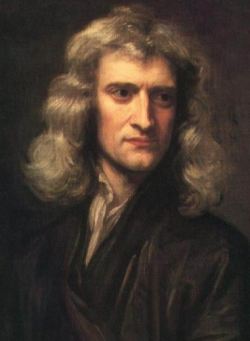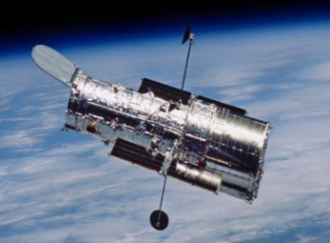Home • Inspiration • Geniuses


Sir Isaac Newton
He made many advancements in the study of light and optics
He proved that white light was heterogenous and composed of many colors with various degrees of refrangibility.
He invented the reflector telescope which was shorter, lighter and could gather more light than a refractor telescope of the same cost. Also, the reflector telescope is not as susceptible to distortion from chromatic aberration as is the refractor telescope. In fact, the reflector telescope is the primary type of optical telescope used today for serious astronomy. This includes the Hubble telescope.
He proposed the theory that light was made of particles-a view that was hotly contested by other scientists of his day. Centuries later, Albert Einstein demonstrated that light existed as particles (photons).

The Hubble telescope owes its existence to Newton
He was the co-inventor of the types of mathematics known as Differential and Integral Calculus
Independently of Gottfried Leibniz, he invented the method of fluxions (Calculus) which he used to calculate orbital paths.
He published the Philosophiae Naturalis Principia Mathematica.
In this work, he explained the 3 laws of motion. He described the force of gravity as a universally attractive force between all objects, and that this force is proportional to the product of the masses of the objects and is inversely proportional to the square of the distance between their centers of mass. He proved that this force, which causes an apple to fall, is the same force that keeps the Moon in orbit around the Earth, and keeps the Earth in orbit around the Sun. Prior to Isaac Newton, people believed that the Earth and the Heavens were governed by different sets of laws. Newton proved that they were governed by the same universal laws. Consequently, this work was considered to be one of the most important scientific publications of all time.
In addition to Differential and Integral Calculus, Newton invented the Calculus of Variations
Bernoulli proposed a math problem called "The Brachistochrone Problem" to many of the top mathematicians in the world at that time including Leibniz (the other co-inventor of Calculus). After many months, Leibniz and the others pursuaded Bernoulli to increase the time limit to 1 year due to the problem's difficulty. Newton received the problem when he got home from work one day. By the next morning, he had invented an entirely new branch of Calculus called the Calculus of Variations, used it to solve the problem, and sent the solution back by mail. This feat has earned him the distinction of being possibly the greatest mathematical genius of all time.
Sir Isaac Newton had more achievements than those listed above and he probably made greater contributions to science than any other person in history. It is even more amazing when you consider that he actually spent more time studying the humanities than the sciences. Newton's genius is beyond all reasonable doubt. Being one of the greatest scientists and mathematicians to have ever lived, he has proven himself to be a genius of geniuses.
Previous genius Next genius


Sir Isaac Newton
Sir Isaac Newton
Isaac Newton was born prematurely on Christmas, 1642 in Woolsthorpe, England. His father died before he was born. When he was still barely a toddler, his mother handed him off to his grandmother and left to marry a rich man from a nearby town. His mother basically ignored him until after her rich husband died. When he was 11, his mother returned and pulled him out of school because she needed him to run the farm. Thankfully for the world, he was a lousy farmer. He eventually went back to school and then on to Cambridge University. He worked odd jobs to pay his way through the first 3 years and got a scholarship for the 4th year. He went back home shortly after his graduation because the university was closed due to the plague. That was the start of his long career of advancing science and math. His works included the following:He made many advancements in the study of light and optics
He proved that white light was heterogenous and composed of many colors with various degrees of refrangibility.
He invented the reflector telescope which was shorter, lighter and could gather more light than a refractor telescope of the same cost. Also, the reflector telescope is not as susceptible to distortion from chromatic aberration as is the refractor telescope. In fact, the reflector telescope is the primary type of optical telescope used today for serious astronomy. This includes the Hubble telescope.
He proposed the theory that light was made of particles-a view that was hotly contested by other scientists of his day. Centuries later, Albert Einstein demonstrated that light existed as particles (photons).

The Hubble telescope owes its existence to Newton
He was the co-inventor of the types of mathematics known as Differential and Integral Calculus
Independently of Gottfried Leibniz, he invented the method of fluxions (Calculus) which he used to calculate orbital paths.
He published the Philosophiae Naturalis Principia Mathematica.
In this work, he explained the 3 laws of motion. He described the force of gravity as a universally attractive force between all objects, and that this force is proportional to the product of the masses of the objects and is inversely proportional to the square of the distance between their centers of mass. He proved that this force, which causes an apple to fall, is the same force that keeps the Moon in orbit around the Earth, and keeps the Earth in orbit around the Sun. Prior to Isaac Newton, people believed that the Earth and the Heavens were governed by different sets of laws. Newton proved that they were governed by the same universal laws. Consequently, this work was considered to be one of the most important scientific publications of all time.
In addition to Differential and Integral Calculus, Newton invented the Calculus of Variations
Bernoulli proposed a math problem called "The Brachistochrone Problem" to many of the top mathematicians in the world at that time including Leibniz (the other co-inventor of Calculus). After many months, Leibniz and the others pursuaded Bernoulli to increase the time limit to 1 year due to the problem's difficulty. Newton received the problem when he got home from work one day. By the next morning, he had invented an entirely new branch of Calculus called the Calculus of Variations, used it to solve the problem, and sent the solution back by mail. This feat has earned him the distinction of being possibly the greatest mathematical genius of all time.
Sir Isaac Newton had more achievements than those listed above and he probably made greater contributions to science than any other person in history. It is even more amazing when you consider that he actually spent more time studying the humanities than the sciences. Newton's genius is beyond all reasonable doubt. Being one of the greatest scientists and mathematicians to have ever lived, he has proven himself to be a genius of geniuses.
Previous genius Next genius

